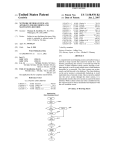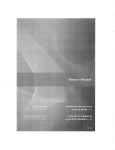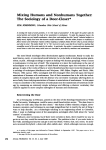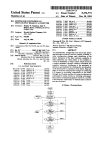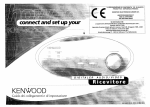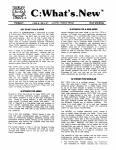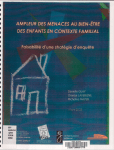Download Mixing Humans and Nonhumans Togethel-: The
Transcript
Mixing Humans and Nonhumans Togethel-: The Sociology of a Door-Closer
c
........
,,®
Jim Jo hnson
Social Problems, Vol. 35, No.3, Special Issue: The Sociology of Science and Technology. (Jun .,
J988) , pp. 29~-310.
Stable URL 11lt p l/ liI1k ~ .(Slor ,oll.!/sic i
}, i c i ~OO '\7- 770
I <;:;. 28 I 98806'7t 201';');
~AYl J('')'.l8(,{
<AMll r\!\'TT'I; <F2 .OC '(l'/' .'l H2 -I' SociaL Problell1s is cun ently publi shed by University of California Press .
or
Your use of the .lSTOR archlvc indicates your accepta nce of JSTOR' s Terms and Cond itions lJse, available ill
JSTO){ 's Terms and Condilions oj Use plO V ides, in part, Ihat UilleSS you have obtain ed
prior permissi on, you may not download an cntire issue of a Journal or multiple copies of articles, and yo u may use content in
the JSTOR iIlchi ve onl y fo r your personal , nOll-commcrcial use.
\111 1': / /\\'\\'\\. i, lmmg/;,ilolllirnms .hl mi.
Plea se eo nlact Ihe jlublish.::r regarding any further use of thi s work. Pu bli sher co ntact information ma y be obtained at
ill! p I/\\'\\' w . jSlor .orr) (Ol(lIl als/ucil I.h tIlli .
Each copy of any part of a JSTOR Iran smission must contain the saIlle co pyri gh l noti ce that appea rs on the screen or printed
page of such transmissio n.
The JSTOR Arc hive is a trusted digitalrcpositOlY plOviding [or long-te rm prese rvation and access to leading academic
journals and scholarly literature from aro und the worl d. The Archive IS supJloned by libraries, scholill'ly soc iet ies, publishers.
~Ild foundation s. It is <1 11 illiti at ive o f JSTOn , a not-I'm-profit orga ni zation wi th a mi ss ion 10 hclp the schola rl y commullity take
adva nt age of advance s in lechnology . f or more information re ga rdin g JSTOR, please contact support@j stoLorg.
http://w\V \V .Jstor .nrg
Sat Nov 17 1237:182007
Mixing Humans and Nonhumans Together:
The Sociology of a Door-Closer*
JIM JOHNSONl, Columbus Ohio School of Mines
Is sociology the study of social questions. or is it the study of associations? In this paper the author takes the
second position and extends the study of our associations to nonhumans. To make the argument clearer. the
author chooses one very humble nonhuman. a door-closer. and analyzes how this "purely" technical arofact is a
highly moral. highly social actor that deserves careful consideration. Then the author proposes a vocabulary to
follow human and nonhuman rdations without stopping at aroficial divides between what is purely technical
and WMI is social. The aUlhor builds "ils " or "his" own texl in such a way IMllhe text itself is a machine lhat
exemplifies several of the points made by the author. In paro·cular. the author is constructed and deconstructed
several times to show how many social actors are insenbed or presen'bed by machines and aUiomatisms.
The most liberal sociologist often discriminates against nonhumans. Ready to study the
most bizarre. exotic. or convoluted social behavior, he or she balks at studying nuclear plants,
robots. or pills. Although sociology is expert at dealing with human groupings, when it comes
to nonhumans. it is less sure of itself. The temptation is to leave the nonhuman to the care of
technologists or to study the impact of black-boxed techniques upon the evolution of social
groups. In spite of the works of Marx or Lewis Mumford and the more recent development of
a sociology of techniques (MacKenzie and Wacjman. 1985; Bijker, Hughes. and Pinch, 1986;
Winner. 1986; Latour, 1987). sociologists still feel estranged when they fall upon the bizarre
associations of humans with nonhumans. Part of their uneasiness has to do with the techni
calities of complex objects and with the absence of a convenient vocabulary allowing them to
move freely from studying associations of human to associations of nonhumans. In this paper
I want to contribute to the reinsertion of nonhumans into the mainstream of American sociol
ogy by examining an extremely simple technique and offering a coherent vocabulary that
could be applied to more complex imbroglios of humans and nonhumans.
Reinventing the Door
On a freezing day in February, posted on the door of the Sociology Department at Walla
Walla University. Washington. could be seen a small hand-written notice: "The door-closer is
on strike, for God's sake, keep the door closed." This fUSion of labor relations, religion. adver
tisement. semiotics, and technique in one single insignificant fact is exactly the sort of thing I
want to help describe. As a technologist teaching in an engineering school in Colombus.
Ohio, I want to challenge some of the assumptions sociologists often hold about the "social
context" of machines.
Walls are a nice invention, but if there were no holes in them. there would be no way to
get in or out; they would be mausoleums or tombs. The problem is that, if you make holes in
the walls. anything and anyone can get in and out (bears, visitors. dust, rats. noise). So archi
tects invented this hybrid: a hole-wall, often called a door. which. although common enough.
... A version of this paper was delivered at Twente. Holland. in September. 1987. This paper owes a lot to
Madeleine Akrlch's work.
1. See page 304 for the social deconstruction of the authors.
298
SOCIAL PROBLEMS. Vol. 35. No.3 . June 1988
Technology and Social Relationships
has always struck me as a miracle of technology. The cleverness of the invention hinges upon
the hinge·pin: instead of driving a hole through walls with a sledge hammer or a pick, you
simply gently push the door (l am supposing here that the lock has not been invented; this
would over-complicate the already highly complex story of this door). Furthermore, and here
is the real trick, once you have passed through the door, you do not have to find trowel and
cement to rebuild the wall you have just destroyed; you simply push the door gently back (I
ignore for now the added complication of the "pull" and "push" signs).
So, to size up the work done by hinges, you simply have to imagine that every time you
want to get in or out of the building you have to do the same work as a prisoner trying to
escape or a gangster trying to rob a bank, plus the work of those who rebuild either the
prison's or the bank's walls.
If you do not want to imagine people destroying walls and rebuilding them every time
they wish to leave or enter a building, then imagine the work that would have to be done in
order to keep inside or to keep outside all the things and people that. left to themselves, would
go the wrong way. As Maxwell could have said, imagine his demon working witlwut a door.
Anything could escape from or penetrate into the department, and there would soon be com
plete equilibrium between the depressing and noisy surrounding area and the inside of the
building. Techniques are always involved when asymmetry or irreversibility is the goal; it
might appear that doors are a striking counter example since they maintain the hole-wall in a
reversible state, but the allusion to Maxwell's demon clearly shows that such is not the case.
The reversible door is the only way to irreverSibly trap inside a differential accumulation of
warm sociologists. knowledge, papers, and also, alas, paperwork; the hinged door allows a
selection of what gets in and what gets out so as to locally increase order or information. If
you let the draft~ get inside, the drafts will never get outside to the publishers.
Now, draw two columns (if I am not allowed to give orders to the teader of Social Problems
then take it as a piece of strongly worded advice). In the right column, list the work people
would have to do if they had no door; in the left column write down the gentle pushing (or
pulling) they have to do in order to fulfill the same tasks. Compare the two columns; the
enormous effort on the right is balanced by the little one on the left, and this thanks to hinges.
I will define this transformation of a major effort into a minor one by the word translation or
delegation; I will say that we have delegated (or translated or displaced or shifted out) to the
hinge the work of reversibly solving the hole-wall dilemma. Calling on a sociologist friend, I
do not have to do this work nor even to think about it; it was delegated by the carpenter to a
character. the hinge, that I will call a nonhuman (notice that I did not say "inhuman"). I
simply enter the department of sociology. As a more general descriptive rule, every time you
want to know what a nonhuman does, simply imagine what other humans or other
nonhumans would have to do were this character not present. This imaginary substitution
exactly sizes up the role, or function, of this little figure.
Before going on, let me cash out one of the side benefits of this table: in effect. we have
drawn a scale balance where tiny efforts balance out mighty weights. The scale we drew (at
least the one that you drew jf you have obeyed my orders-I mean, followed my advice)
reproduces the very leverage allowed by hinges. That the small be made stronger than the
large is a very moral story indeed (think of David and Goliath). By the same token, this is also,
since at least Archimedes' days, a very good definition of a lever and of power: the minimum
you need to hold and deploy astutely in order to produce the maximum effect. Am I alluding
to machines or to Syracuse's King? I don't know, and it does not matter since the King and
Archimedes fused the two "minimaxes" into one single story told by Plutarch: the defense of
Syracuse. I contend that this reversal of forces is what sociologists should look at in order to
understand the "social construction" of techniques and not at a hypothetical SOCial context
they are not equipped to grasp. This little point having been made, let me go on with the
Z99
)00
LATOUR
story (we will understand later why I do not really need your permission to go on and why ,
nevertheless, you are free not to go on, although only relatively so).
Delegating to Humans
There is a problem with doors. Visitors push them to get in or pull on them to get out (or
vice versa), but then the door remains open. That is, instead of the door you have a gaping
hole in the wall through which, for instance, cold rushes in and heat rushes out. Of course,
you could imagine that people living in the building or visiting the department of sociology
would be a well disciplined lot (after all, sociologists are meticulous people). They will learn
to close the door behind them and retransform the momentary hole into a well-sealed wall.
The problem is that discipline is not the main characteristic of people. Are they going to be so
well-behaved? Closing a door would appear to be a simple enough piece of know-how once
hinges have been invented; but, considering the amount of work, innovations, sign-posts,
recriminations that go on endlessly everywhere to keep them closed (at least in Northern
regions), it seems to be rather poorly disseminated.
This is where the age-old choice, so well analyzed by Mumford (1966), is offered to you :
either to discipline the people or to suhstitute for the unreliable people another delegated human
character whose only function is to open and close the door. This is called a groom or a porter
(from the French word for door) or a gatekeeper, or a janitor, or a concierge, or a turnkey, or a
gaoler. The advantage is that you now have to discipline only one human and may safely
leave the others to their erratic behavior. No matter who these others are and where they
come from, the groom will always take care of the door. A nonhuman (the hinges) plus a
human (the groom) have solved the hole-wall dilemma.
Solved? Not quite. First of alL if the department pays for a porter, they will have no
money left to buy coffee or books or to invite eminent foreigners to give lectures. If they give
the poor little boy other duties besides that of porter, then he will not be present most of the
time, and the damned door will stay open. Even if they had money to keep him there, we are
now faced with a problem that two hundred years of capitalism has not completely solved:
how to diScipline a youngster to reliably fulfill a boring and underpaid duty. Although there
is now only one human to be disciplined instead of hundreds (in practice only dozens because
Walla Walla is rather difficult to locate), the weak point of the tactic is now revealed: if this
one lad is unreliable then the whole chain breaks down. If he falls asleep on the job or goes
walkabout, there will be no appeal; the damned door will stay open (remember that locking it
is no solution since this would turn it into a walL and then providing every visitor with the
right key is an impossible task). Of course, the little rat may be punished or even flogged. But
imagine the headlines: "Sociologists of science flog porter from poor working class back
ground." And what if he is black, which might very well be the case, given the low pay? No,
disciplining a groom is an enormous and costly task that only Hilton Hotels can tackle, and
that for other reasons that have nothing to do with keeping the door properly closed.
If we compare the work of disciplining the groom with the work he substitutes for, ac
cording to the list defined above, we see that this delegated character has the opposite effect to
that of the hinge. A simple task, forcing people to close the door, is now performed at an
incredible cost; the minimum effect is obtained with maximum spending and spanking. We
also notice, when drawing the two lists, an interesting difference. In the first relationship
(hinges vis-a-vis work of many people), you not only had a reversal of forces (the lever allows
gentle manipulations to heavy weights) but also a reversal of time. Once the hinges are in
place, nothing more has to be done apart from maintenance (oiling them from time to time).
In the second set of relations (groom's work versus many people's work), not only do you fail
to reverse the forces , but you also fail to modify the time schedule. Nothing can be done to
Technology and Social Relationships
prevent the groom who has been reliable for two months from failing on the sixty-second day;
at this point it is not maintenance work that has to be done, but the same work as on the first
day-apart from the few habits that you might have been able to incorporate into his body.
Although they appear to be two similar delegations, the first one is concentrated in time,
whereas the other is continuous; more exactly, the first one creates a clear-cut distinction
between production and maintenance, whereas in the other the distinction between training
and keeping in operation is either fuzzy or nil. The first one evokes the past perfect ("o nce
hinges had been installed"); the second the present tense ("when the groom is at his post").
There is a built-in inertia in the first that is largely lacking in the second. A profound tempo
ral shift takes place when nonhumans are appealed to: time is folded.
Disciplining the Door·Closer
It is at this point that you have this relatively new choice: either to discipline the people
or to substitute for the unreliable humans a delegated nonhuman character whose only func
tion is to open and close the door. This is called a door-closer or a "groom." The advantage is
that you now have to discipline only one nonhuman and may safely leave the others (bell
boys included) to their erratic behavior. No matter who they are and where they come
from-polite or rude, quick or slow, friends or foes-the nonhuman groom will always take
care of the door in any weather and at any time of the day. A nonhuman (hinges) plus
another nonhuman (groom) have solved the hole-wall dilemma.
Solved? WelL not quite. Here comes the deskilling question so dear to social historians of
technology : thousands of human grooms have been put on the dole by their nonhuman
brethren . Have they been replaced? This depends on the kind of action that has been trans
lated or delegated to them. In other words, when humans are displaced and deskilled,
nonhumans have to be upgraded and reskilled. This is not an easy task, as we shall now see.
We have all experienced having a door with a powerful spring mechanism slam in our
face. For sure, springs do the job of replacing grooms, but they play the role of a very rude,
uneducated porter who obviously prefers the wall version of the door to its hole version.
They simply slam the door shut. The interesting thing with such impolite doors is this: if they
slam shut so violently, it means that you, the visitor, have to be very quick in passing through
and that you should not be at someone else's heels; otherwise your nose will get shorter and
bloody. An unskilled nonhuman groom thus presupposes a skilled human user. It is always a
trade-off. I will calL after Madeleine Akrich, the behavior imposed back onto the human by
nonhuman delegates prescn'ption (Akrich, 1987). How can these prescriptions be brought out?
By replacing them by strings of sentences (usually in the imperative) that are uttered (silently
and continuously) by the mechanisms for the benefit of those who are mechanized: do this,
do that, behave this way, don't go that way. Such sentences look very much like a program
ming language. This substitution of words for silence can be made in the analyst's thought
experiments, but also by instruction booklets or explicitly in any training session through the
voice of a demonstrator or instructor or teacher. The military are especially good at shouting
them out through the mouthpiece of human instructors who delegate back to themselves the
task of explaining, in the rifle's name, the characteristics of the rifle's ideal user. As Akrich
notes, prescription is the moral and ethical dimension of mechanisms. In spite of the constant
weeping of moralists, no human is as relentlessly moral as a machine, especially if it is (she is,
he is, they are) as "user friendly" as my computer.
The results of such distributions of skills between humans and nonhumans is well
known : members of the department of sociology will safely pass through the slamming door
at a good distance from one another; visitors, unaware of the local cultural condition, will crowd
through the door and will get bloody noses. This story is of the same form as that about the
)01
)02
LATOUR
buses loaded with poor blacks that could not pass under driveways leading to Manhattan
parks (Winner, 1980). So, inventors get back to their drawing board and try to imagine a
nonhuman character that will not prescribe the same rare local cultural skills to its human
users. A weak spring might appear to be a good solution. Such is not the case because it
would substitute for another type of very unskilled and undecided groom who is never sure
about the door's (or his own) status: is it a hole or a walJ? Am I a closer or an opener? If it is
both at once, you can forget about the heat. In computer parlance, a door is an OR. not an
AND gale.
I am a great fan of hinges, but I must confess that I admire hydraulic door-closers much
more, especially the old copper plated heavy one that slowly closed the main door of our
house in Colombus, Ohio. I am enchanted by the addition to the spring of an hydraulic piston
which easily draws up the energy of those who open the door and retains it. then gives it back
slowly with a subtle variety of implacable firmness that one could expect from a well trained
butler. Especially clever is its way of extracting energy from each and every unwilling. unwit
ting passer-by. My military friends at the academy call such a clever extraction an "obligatory
passage point," which is a very fitting name for a door; no matter what you feel. think, or do,
you have to leave a bit of your energy, literally, at the door. This is as clever as a toll booth.
This does not quite solve all the problems, though. To be sure the hydraulic door-closer
does not bang the noseS of those who are not aware of local conditions, so its prescriptions
may be said to be less restrictive. But it still leaves aside segments of human populations.
Neither my little nephews nor my grandmother could get in unaided because our groom
needed the force of an able-bodied person to accumulate enough energy to close the door. To
use the classic Langdon Winner's motto (1980), because of their prescriptions these doors dis
cn'minate against very little and very old persons. Also, if there is no way to keep them open
for good, they discriminate against furniture removers and in general everyone with pack
ages, which usually means. in our late capitalist society. working or lower-middle class em
ployees (who, even coming from a higher strata, has not been cornered by an automated
butler when he or she had their hands full of packages?). There are solutions though: the
groom's delegation may be written off (usually by blocking its arm) or. more prosaically, its
delegated action may be opposed by a foot (salesman are said to be expert at thiS). The foot
may in turn be delegated to a carpet or anything that keeps the butler in check (although I am
always amazed by the number of objects that fail this trial of force. and I have very often seen
the door I just wedged open politely closing when I turned my back to it).
As a technologist. I could claim that, provided you put aside maintenance and the few
sectors of population that are discriminated against, the groom does its job welL closing the
door behind you constantly. firmly. and slowly. It shows in its humble way how three rows
of delegated nonhuman actants (hinges, springs, and hydraulic pistons) replace. 90 percent of
the time, either an undisciplined bell-boy who is never there when needed or. for the general
public, the program instructions that have to do with remembering-to-close-the-door-when-it
is-cold. The hinge plus the groom is the technologist's dream of efficient action. at least it was
until the sad day when I saw the note posted on Walla Walla Sociology Department's door
with which I started this article: "the groom is on strike." So not only have we been able to
delegate the act of clOSing the door from the human to the nonhuman, we have also been able
to delegate the little rat's lack of discipline (and maybe the union that goes with it). On strike.
Fancy thatl Nonhumans stopping work and claiming what? Pension payments? Time off?
Landscaped offices? Yet it is no use being indignant because it is very true that nonhumans
are not so reliable that the irreversibility we would like to grant them is complete. We did not
want ever to have to think about this door again-apart from regularly scheduled routine
maintenance (which is another way of saying that we did not have to bother about it)-and
here we are, worrying again about how to keep the door closed and drafts outside.
What is interesting in the note on the door is the humor of attributing a human character
Technology and Social Relationships
to a failure that is usually considered as "purely technical." This humor, however, is more
profound than the synonymous notice they could have posted "the groom is not working," I
constantly talk with my computer, who answers back; I am sure you swear at your old car;
we are constantly granting mysterious faculties to gremlins inside every conceivable home
appliance, not to mention cracks in the concrete belt of our nuclear plants, Yet. this behavior
is considered by moralists, I mean sociologists, as a scandalous breach of natural barriers,
When you write that a groom is "on strike." this is only seen as a "projection," as they say, of a
human behavior onto a nonhuman cold technical object, one by nature impervious to any
feeling, They call such a projection anthropomorphism, which for them is a sin akin to
zoophily but much worse,
H is this sort of moralizing that is so irritating for technologists because the automatic
groom is already anthropomorphic through and through. "Anthropos" and "morphos" to
gether mean either what has human shape or what gives shape to humans. Well the groom is
indeed anthropomorphic, and in three senses: first, it has been made by men, it is a construc
tion; second it substitutes for the actions of people. and is a delegate that permanently occu
pies the position of a human; and third, it shapes human action by prescribing back what sort
of people should pass through the door. And yet some would forbid us to ascribe feelings to
this thoroughly anthropomorphic creature, to delegate labor relations, to "project"-that is to
say, to translate--other human properties to the groom, What of those many other innovations
that have endowed much more sophisticated doors with the ability to see you arrive in ad
vance (electronic eyes), or to ask for your identity (electronic passes), or to slam shut-<>r
open-in case of danger? But anyway. who are you, you the sociologists, to decide forever the
real and final shape of humans, to trace with confidence the boundary between what is a
"real" delegation and what is a "mere" projection, to sort out forever and without due inquiry
the three different kinds of anthropomorphism I listed above? Are we not shaped by nonhu
man grooms, although, I admit, only a very little bit? Are they not our brethren,) Do they not
deserve consideration? With your self-serving and self-righteous social problems, you always
plead against machines and for deskilled workers; are you aware of your discriminatory bi
ases? You discriminate between the human and the inhuman. [do not hold this bias but see
only actors-some human, some nonhuman, some skilled, some unskilled-that exchange
their properties,
So the note posted on the door is an accurate one. It gives a humorous but exact render
ing of the groom's behavior: it is not working; it is on strike (notice, that the word "strike" is
also an anthropomorphism carried from the nonhuman repertoire to the human one, which
proves again that the divide is untenable). What happens is that SOciologists confuse the di
chotomy humanlinhuman with another one: jigurative/nonjigurative, If I say that Hamlet is
the figuration of "depression among the aristocratic class," I move from a personal figure to a
less personal one (class), If I say that Hamlet stands for doom and gloom, I use less figurative
entities: and if I claim that he represents western civilization, I use non-figurative abstrac
tions. Still, they all are equally actants, that is to say entities that do things, either in Shake
speare's artful plays or in the commentators' more tedious tomes, The choice of granting
actants figurativity or not is left entirely to the authors. It is exactly the same for techniques,
We engineers are the authors of these subtle plots or scenan'/s, as Madeleine Akrich (1987) calls
them, of dozens of delegated and interlocking characters so few people know how to appreci
ate. The label "inhuman" applied to techniques simply overlooks translation mechanisms
and the many choices that exist for figuring or de-figuring, personifying or abstracting, em
bodying or disembodying actors .
For instance, on the freeway the other day, I slowed down because there was a guy in a
yellow suit and a red helmet waving a red flag. Well, the guy's moves were so regular and he
was located so dangerously and had such a pale although smiling face that, when I passed by,
I recognized it to be a machine (it failed the Turing test, a cognitivist would say). Not only was
}O}
}<M
LATOUR
the red flag delegated, not only was the arm waving the flag also delegated, but the body
appearance was also added to the machine. We engineers could move much further in the
direction of figuration, although at a cost; we could have given him/her (careful here, no
sexual discrimination of robots) electronic eyes to wave only when there is a car approaching
or regulated the movement so that it is faster when cars do not obey. Also we could have
added-why not?-a furious stare or a recognizable face like a mask of President Reagan,
which would have certainly slowed drivers down very efficiently . But we could also have
moved the other way, to a less figurative delegation; the flag by itself could have done the job.
And why a flag? Why not simply a sign: "work in progress"? And why a sign at all? Drivers,
if they are circumspect. disciplined, and watchful will see for themselves that there is work in
progress and will slow down.
The enunciator (a general word for the author of a text or for the mechanics who devised
the machine) is free to place or not a representation of himself or herself in the script (texts or
machines). The engineer may delegate or not in the flag-mover a shape that is similar to him/
herself. This is exactly the same operation as the one I did in pretending that the author of
this article was a hardcore technologist from Colombus, Ohio. If I say "we, the technologists,"
I propose a picture of the author-of-the-text which has only a vague relation with the author
in-the-flesh, in the same way as the engineer delegates in his flag-mover a picture of him that
bears little resemblance to him/her2 But it would have been perfectly possible for me and for
the mechanics to position no figurated character at all as the author in the scripts of our scripts
(in semiotic parlance there would be no narrator). I would just have had to say things like
"recent developments in sociology of science have shown that" instead of "1." and the
mechanics would simply have had to take out the dummy worker and replace it by cranks
and pullies.
Appealing to Gods
Here comes the most interesting and saddest lesson of the note posted on the door : people
are not circumspect. disciplined, and watchfuL especially not Walla Walla drivers after the
happy-hour on Friday night. Well. that's exactly the point that the note made: "The groom is
on strikeJor God's sake, keep the door closed." In our societies, they are two systems of appeal:
nonhuman and super-human, that is machines and gods. This note indicates how desperate
its frozen and anonymous authors were (I have never been able to trace them back and to
honor them as they deserved). They first relied on the inner morality and common sense of
humans. This failed; the door was always left open. Then they appealed to what we technol
ogists consider the supreme court of appeal. that is, to a nonhuman who regularly and conve
niently does the job in place of unfaithful humans. To our shame, we must confess that it also
failed after a while. The door was again always left open. How poignant their line of thought
is! They moved up and backward to the oldest and firmest court of appeal there is. there was.
and ever will be. If human and nonhuman have failed, certainly God will not deceive them.
2. The author-in·the text is Jim Johnson. technologist in Columbus. Ohio_ who went to Walla Walla University.
whereas the aUlhor-in' lhe-flesh is Bruno LalOur. sociologist. from Paris, France, who never went to Columbus nor to
Walla Walla University. The distance between the two is great but similar to that b<.>tween Steven Jobs. the Invenlor of
Macintosh, and the figurative nonhuman character who/which says "welcome to Macintosh" when you switch on your
computer. The reason for this use of pseudonym was the opinion of the editors that no American sociologist is willing to
read things that refer to speCific places and times which are not American. Thus I inscribed in my text American scenes
so as to decrease the gap between the prescribed reader and the pre-Inscribed one. (Edilors ' Nolt: Since we believed these
locations 10 be unimportant to Bruno Latour's argument, we urged him to remove specific place references that might
have been unfamiliar to U.S. readers and thus possibly distracting. His solution seems to have proven our point. Corre·
spondence to the aUlhor·ln·lhe·flesh should go to Centre de Sociologie de I'lnnovation, Ecole Nationate Superieure des
Mines, 62 boulevard Saint-Michel. 75006 Paris. France .)
Technology and Social Relationships
I am ashamed to say that, when I crossed the hallway this fatal February day, the door was
open. Do not accuse God, though, because the note did not appeal directly to Him (1 know I
should have added "Her" for affirmative action reasons, but I wonder how theologians would
react) . God is not accessible without mediators. The anonymous authors knew their cate
chisms well. so instead of asking for a direct miracle (God Him/Herself holding the door firmly
closed or doing so through the mediation of an angel. as has happened in several occasions,
for instance when Paul was delivered from his prison), they appeal to the respect for God in
human hearts. This was their mistake. In our secular times, this is no longer enough.
Nowadays nothing seems to do the job of disciplining men and women and forcing them
simply to close doors in cold weather. It is a similar despair that pushed the road engineer to
add a Golem to the red flag to force drivers to beware-although the only way to slow drivers
is still a good traffiC-jam. You seem to always need more and more of these figurated delegates
aligned in rows. It is the same with delegates as with drugs; you start with soft ones and end
by shooting up. There is an inflation for delegated characters too. After a while they weaken.
In the old days it might have been enough just to have a door for people to know how to close
it. But then, the embodied skills somehow disappeared; people had to be reminded of their
training. Still. the simple inscription "keep the door closed" might have been sufficient in the
good old days. But you know people; they no longer pay attention to such notices and need to
be reminded by stronger devices. It is then that you install automatic grooms, since electric
shocks are not as acceptable for men as for cows. In the old times, when quality was still
good, it might have been enough just to oil it from time to time, but nowadays even automa
tisms go on strike.
It is not, however, that the movement is always from softer to harder devices, that is,
from an autonomous body of knowledge to force through the intermediary situation of
worded injunctiOns, as the Walla Walla door would suggest. It also goes the other way.
Although the deskilling thesiS appears to be the general case (always go from intra-somatic to
extra-somatic skills; never rely on undisciplined men, but always on safe delegated
nonhumans), this is far from true. For instance, red lights are usually respected, at least when
they are sophisticated enough to integrate traffic flows through sensors. The delegated police
men standing there day and night is respected even though it has no whistles, gloved hands,
and body to enforce this respect. Imagined collisions with the other cars or with the absent
policemen are enough to keep drivers and cars in check. The thought experiment "what
would happen if the delegated character was not there," is the same as the one I recom
mended above to size up its function. The same incorporation from written injunction to
body skills is at work with car user manuals. No one, I guess, will cast more than a cursory
glance at the manual before igniting the engine. There is a large body of skills that we have
now so well embodied or incorporated that the mediations of the written instructions are
useless. From extra-somatic they have become intra-somatic. Incorporation in human or in
nonhuman bodies is also left to the authors/engineers.
Offering a Coherent Vocabulary
It is because humans, nonhumans, and even angels are never sufficient in themselves
and because there is no one direction going from one type of delegation to the other, that it is
so useless to impose a priori divisions between which skills are human and which ones are
not human, which characters are personified and which remain abstract, which delegation is
forbidden and which is permissible, which type of delegation is stronger or more durable than
the other. In place of these many cumbersome distinctions why not take up a few simple
descriptive tools?
Following Madeleine Akrich's lead, we will speak only in terms of scnpts or scenes or
]05
306
LATOUR
scenarios played by human or nonhuman actors, which may be either figurative or non
figurative . Humans are not necessarily figurative; for instance you are not allowed to take the
highway policeman as an individual chum. He/she is the representative of authority, and if
he/she is really dumb, he/she will reject any individualizing efforts from you, like smiles,
jokes, bribes, or fits of anger. He/she will fully play th~ administrative machinery.
Following Akrich, I will call the retrieval of the script from the situation description.
These descriptions are always in words and appear very much like semiotic commentaries on
a text or like a programming language. They define actors, endow them with competences
and make them do things, and evaluate the sanction of these actions very much like the
narrative program of semioticians.
Although most of the scripts are in practice silent either because they are intra- or extra
somatic. the written descriptions are not an artifact of the analyst (technologist, sociologist, or
semiotician) because there exist many states of affairs in which they are explicitly uttered. The
gradient going from intra-somatic to extra-somatic skills through discourse is never fully stabi
lized and allows many entries revealing the process of translation. I have already listed sev
eral entries: user manuals, instruction, demonstration or drilling situations (in this case a
human or a speech-synthesizer speaks out the user manual), practical thought experiments
("what would happen if instead of the red light a policemen were there"). To this should be
added the innovator's workshop where most of the objects to be devised are still at the stage of
projects committed to paper Cif we had a device doing this and that, we could then do this
and that"); market analysis in which consumers are confronted with the new device; and,
naturally, the training situation studied by anthropologists where people faced with a foreign
device talk to themselves while trying out various combinations ("what will happen if I attach
this lead here to the mains?"). The analyst has to capture these situations in order to write
down the scripts. The analyst makes a thought experiment by comparing presence / absence
tables and collating all the actions done by actants: if I take this one away, this and that other
action will be modified.
I will call the translation of any script from one repertoire to a more durable one tramenp
l-ion or inscnption or encoding. Translation does not have here only its Iingubtic meaning but
also the religious one, "translation of the remains of St ChristeL" and the artistic one, "translat
ing the feelings of Calder into bronze." This definition does not imply that the direction al
ways goes from soft bodies to hard machines, but simply that it goes from a prOVisional less
reliable one (0 a longer-lasting, more faithful one. For instance, the embodiment in cultural
tradition of the user manual of a car is a transcription, but so is the replacement of a police
man by a traffic-light. One goes from machines to bodies, whereas the other goes the other
way. Specialists of robotics have very much abandoned the pipe dream of total automation;
they learned the hard way that many skills are better delegated to humans than to
nonhumans, whereas others may be moved away from incompetent humans.
I will call prescnptl'on whatever a scene presupposes from its transcribed actors and authors
(this is very much like "role expectation" in sociology, except that it molY be inscribed or
encoded in the machine). For instance, a Renaissance Italian painting is designcd to be
viewed from a specific angle of view prescribed by the vanishing lines, exactly like a traffic
light expects that its users will watch it from the street and not sideways. In the same way as
they presuppose a user, traffic lights presuppose that there is someone who has regulated the
lights so that they have a regular rhythm. When the mechanism is stuck it is very amusing to
see how long it takes drivers before deciding that the traffic light is no longer mastered by a
reliable author. "User input" in programming language is another very telling example of this
inscription in the automatism of a living character whose behavior is both free and
predetermined.
This inscription of author and users in the scene is very much the same as that of a text. I
already showed how the author of this article was ascribed (wrongly) to be a technologist in
Technology and Social Relationships
Ohio. It is the same for the reader . I have many times used "you" and even "you sociolo
gists." If you remember welL I even ordered you to draw up a table (or advised you to do so).
I also asked your permission to go on with the story. In doing so, I built up an inscribed reader
to whom r prescribed qualities and behavior as surely as the traffic light or the painting pre·
pared a position for those looking at them. Did you suhscrihe to this definition of yourself? Or
worse, is there anyone at all to read this text and occupy the position prepared for the reader?
This question is a source of constant difficulties for those who do not grasp the basics of semio
tics . Nothing in a given scene can prevent the inscribed user or reader from behaving differ
ently from what was expected (nothing, that is, until the next paragraph). The reader-in-the
flesh may totally ignore my definition of him or her. The user of the traffic light may well
cross on the red . Even visitors to the department of sociology may never show up because
Walla Walla is too far away, in spite of the fact that their behavior and trajectory have been
perfectly anticipated by the groom. As for the computer user input, the cursor might flash for
ever without the user being there or knowing what to do. There might be an enormous gap
between the prescribed user and the user-in-the-flesh, a difference as big as the one between
the "1" of a novel and the novelist. It is exactly this difference that so much upset the authors
of the anonymous appeal posted on the door. It is because they could not discipline people
with words, notes, and grooms, that they had to appeal to God. On another occasion, how
ever, the gap between the two may be nil: the prescribed user is so well anticipated, so care
fully nested inside the scenes, so exactly dovetailed, that it does what is expected. To stay
within the same etymological root, I would be tempted to call the way actors (human or
nonhuman) tend to extirpate themselves from the prescribed behavior des-inscription and the
way they accept or happily acquiesce to their lot subscnption.
The problem with scenes is that they are usually well prepared for anticipating users or
readers who are at close quarter. For instance, the groom is quite good in its anticipation that
people will push the door open and give it the energy to reclose it. It is very bad at doing
anything to help people arrive there. After fifty centimeters, it is helpless and cannot act. for
example, to bring people to Washington state. Still, no scene is prepared without a precon
ceived idea of what sort of actors will come to occupy the prescribed positions. This is why I
said that, although you were free not to go on with this paper, you were only "relatively" so.
Why? Because I know you are hard-working, serious American sociologists, reading a serious
issue of Social Problems on sociology of science and technology. So, I can safely bet that I have
a good chance of having you read the paper thoroughly! So my injunction "read the paper up
to the end, you sociologist" is not very risky. I will call pre-inscription all the work that has to
be done upstream of the scene and all the things assimilated by an actor (human or nonhu
man) before coming to the scene as a user or as an author. For instance, how to drive a car is
basically pre-inscribed in any (western) youth years before he or she comes to passing the
driving licence test; hydraulic pistons were also pre-inscribed for slowly giving back the en
ergy gathered years before innovators brought them to bear on automated grooms. Engineers
can bet on this pre-determination when they draw up their prescriptions. This is what Gerson
and his colleagues call "articulation work" (Fujimura, 1987). A lovely example of efforts at
pre-inscription is provided by Orson Welles in Citizen Kane, where the hero not only bought a
theater for his singing wife to be applauded in, but also bought the journals that were to do
the reviews, bought off the art critics themselves, and paid the audience to show up-all to no
avaiL since the wife eventually quit. Humans and nonhumans are very, very undisciplined
no matter what you do and how many predeterminations you are able to control upstream of
the action.
Drawing a side-conclusion in passing, we can call soci%gism the claim that, given the
competence and pre-inscription of human users and authors, you can read out the scripts
nonhuman actors have to play; and /echn%gism the symmetric claim that given the compe
tence and pre-inscription of the nonhuman actors, you can easily read out and deduce the
}07
108
LATOUR
behavior prescribed to authors and users. From now on. these two absurdities wilL I hope.
disappear from the scene. since the actors at any point may be human or nonhuman and
since the displacement (or translation. or transcription) makes the easy reading-out of one
repertoire into the next impossible. The bizarre idea that society might be made up of human
relations is a mirror image of the other no less bizarre idea that techniques might be made up
of nonhuman relations. We deal with characters. delegates. representatives. or. more nicely,
lieutenants (from the French "lieu" "tenant." i.e., holding the place of. for. someone else);
some figurative, others nonfigurative; some human, others nonhuman; some competent.
others incompetent. You want to cut through this rich diversity of delegates and artificially
create two heaps of refuse: "society" on one side and "technology" on the other? That's your
privilege. but I have a less messy task in mind.
A scene, a text. an automatism can do a lot of things to their prescribed users at close
range. but most of the effect finally ascribed to them depends on a range of other set-ups being
aligned. For instance. the groom closes the door only if there are people reaching the Sociol
ogy Department of Walla Walla. These people arrive in front of the door only if they have
found maps and only if there are roads leading to it; and, of course, people will start bothering
about reading the maps, getting to Washington state and pushing the door open only if they
are convinced that the department is worth visiting. I will call this gradient of aligned set-ups
that endow actors with the pre-inscribed competences to find its users a chreod (a "necessary
path" in the biologist Waddington's Greek): people effortleSSly flow through the door, and the
groom, hundreds of times a day, recloses the door-when it is not stuck. The result of such an
alignment of set-ups is to decrease the number of occasions in which words are used; most of
the actions become silent. familiar, incorporated (in human or in nonhuman bodies)-making
the analyst's job so much harder. Even the classic debates about freedom, determination,
predetermination. brute force, or efficient will- debates which are the twentieth century
version of seventeenth century discussions on grace-Will be slowly eroded away. (Since you
have reached this point, it means I was right in saying earlier that you were not at all free to
stop reading the paper. POSitioning myself cleverly along a chreod, and adding a few other
tricks of my own, I led you here . .. or did I? Maybe you skipped most of it; maybe you did
not understand a word of it. oh you undisciplined American sociologist readers!)
There is one loose end in my story: why did the little (automatic) rat go on strike? The
answer to this is the same as for the question earlier of why few people show up in Walla
Walla. It is not because a piece of behavior is prescribed by an inscription that the predeter
mined characters will show up on time and do the job expected of them. This is true of
humans, but it is truer of non humans. In this case the hydraulic piston did its job, but not the
spring that collaborated with it. Any of the words above may be used to describe a set-up at
any level and not only at the simple one I chose for the sake of clarity. It does not have to be
limited to the case where a human deals with a series of nonhuman delegates; it can also be
true of relations among non humans. In other words, when we get into a more complicated
lash-up than the groom, we do not have to stop doing sociology; we go on studying "role
expectation," behavior, social relations. The non-figurative character of the actors should not
intimidate us.
The Ueutenants of Our Societies
I used the story of the door-closer to make a nonhuman delegate familiar to the ears and
eyes of sociologists. I also used reflexively the semiotic of a story to explain the relations
between inscription, prescription. pre-inscription. and chreods. There is, however, a crucial
difference between texts and machines that I have to point out. Machines are lieutenants;
Technology and Social Relationships
they hold the places and the roles delegated to them, but this way of shifting is very different
from other types (Latour, I 988b).
In story-telling, one calls shifting out any displacement of a character either to another
space or to another time or to another character. If I tell you "Millikan entered the aula," I
translate the present setting-you and me-and shift it to another space, another time, and to
other characters (Millikan and his audience) . "1." the enunciator, may decide to appear or to
disappear or to be represented by a narrator who tells the story ("that day, I was sitting on the
upper row of the aula"); "I" may also decide to pOSition you and any reader inside the story
Chad you been there, you would have been convinced by Millikan's experiments"). There is
no limit to the number of shiftings out a story may be built with. For instance, ''I'' may well
stage a dialogue inside the aula between two characters who are telling a story about what
happened at the Academy of Science in Washington, DC. In that case, the aula is the place
from which narrators shift out to tell a story about the Academy, and they mayor may not shift
back in the aula to resume the first story about Millikan. "1" may also shift in the entire series
of nested stories to close mine and come back to the situation I started from: you and me. All
these displacements are well-known in literature departments and make up the craft of tal
en ted wri ters.
No matter how clever and crafty are our novelists, they are no match for engineers. Engi
neers constantly shift out characters in other spaces and other times, devise pOSitions for
human and nonhuman users, break down competences that they then redistribute to many
different actants, build complicate narrative programs and sub-programs that are evaluated
and judged . Unfortunately, there are many more literary critiques than there are technologists
and the subtle beauties of techno-social imbroglios escape the attention of the literate public.
One of the reasons for this lack of concern may be the peculiar nature of the shifting-out that
generates machines and devices. Instead of sending the listener of a story into another world,
the technical shifting-out inscribes the words into another matter. Instead of allowing the
reader of the story to be at the same time away (in the story's frame of reference) and here (in
his armchair), the technical shifting-out forces him to chose between frames of reference.
Instead of allowing enunciators and enunciatees a sort of simultaneous presence and commu
nion with other actors, technics allow both of them to ignore the delegated actors and to walk
away without even feeling their presence. 3
To understand this difference in the two directions of shifting out. let us venture out once
more onto a Columbus freeway. For the umpteenth time I have screamed to Robin, "don't sit
on the middle of the rear seat; if I brake too hard, you're dead." In an auto shop further along
the freeway I come across a device made for tired-and-angry-parents-driving-cars-with-kids
between-two-and-five (that is too old for a baby seat and not old enough for a seat belt) and
from-small-families (that is without other persons to hold them safely) and-having-cars-with
two-separated-front-seats-and-head-rests. It is a small market but nicely analyzed by these
Japanese fellows and, given the price, it surely pays off handsomely . This description of my
self and the small category into which I am happy to subscribe is transcribed in the device-a
steel bar with strong attachments to the head rests-and in the advertisement on the outside
of the box. It is also pre-inscribed in about the only place where I could have realized thai I
needed it. the freeway . Making a short story already too long, I no longer scream at Robin
and I no longer try to foolishly stop him with my extended right arm: he firmly holds the bar
that protects him-or so I believe-against my braking. I have delegated the continuous in
junction of my voice and extension of my right arm (with diminishing results as we know
from Feschner's law) to a reinforced, padded, steel bar. Of course, I had to make two detours:
one to my wallet. the second to my tool box. Thirty bucks and five minutes later I had fixed
3. To the shame of our trade, it is an art historian. Michael Baxandall (1985). who offers the most precise descrip·
tion of a technical artifact (a Scottish Iron Bridge) and who shows in most detail the basic distinctions between delegated
acton which remain silent (black·boxed) and the rich series of mediator.; who remain pr(senT in a work of an.
}0'1
no
LATOUR
the device (after making sense of the instructions encoded with Japanese ideograms). The
detour plus the translation of words and extended arm to steel is a shifting out to be sure, but
not of the same type as that of a story. The steel bar has now taken over my competence as
far as keeping my son at arms length is concerned.
in our societies, there are thousands of such lieutenants to which we have delegated
competences, it means that what defines our social relations is, for the most part, prescribed
back to us by nonhumans. Knowledge, morality, craft, force, sociability are not properties of
humans but of humans accompanied by their retinue of delegated characters. Since each of
those delegates ties together part of our social world, it means that studying social relations
without the nonhumans is impossible (Latour, 1988a) or adapted only to complex primate
societies like those of baboons (Strum and Latour, 1987). One of the tasks of sociology is to do
for the masses of nonhumans that make up our modern societies what it did so well for the
masses of ordinary and despised humans that make up our society. To the people and ordi
nary folks should now be added the lively, fascinating, and honorable ordinary mechanism.
If the concepts, habits, and preferred fields of sociologists have to be modified a bit to accom
modate these new masses, it is small price to pay.
Ie
References
Akrich, Madeleine
1987 "Comment Mcrite les objects techniques." Technique et Culture 5:49-63.
Baxandall, Michael
1985 Patterns of Invention . On the Historical Explanation of Pictures. New Haven, CT: Yale
University Press.
Bljker, Wiebe, Thomas Hugues, and Trevor Pinch, eds.
1986 New Developments in the Social Studies of Technology. Cambridge, MA: MIT Press .
Fujimura, Joan
1987 "Constructing 'do-able' problems in cancer research: articulating alignment." Social Studies
of Science 17:257-93.
Latour, Bruno
1987 Science in Action. Cambridge, MA: Harvard University Press.
1988a "How to write Tn( Prina for machines as well as for machinations. " Pp. 20-63 in Brian
Elliot (ed.), Technology and Social Change. Edinburgh: Edinburgh University Press.
1988b "A relativistic account of Einstein's relatiVity." Social Studies of Science 18:3-44.
MacKenzie, Donald and Judy Wacjman, eds.
1985 The Social Shaping of Technology. A Reader. Philadelphia: Milton Keynes and Open
University Press.
Mumford, Lewis
1966 The Myth of the Machine. New York: Harcourt.
Strum, Shirley and Bruno Latour
1987 "Redefining the social link: from baboons to humans." Social Science Information 26:783
802.
Winner. Langdon
1986 The Whale and the Reactor: A Search for the Limits in an Age of High Technology.
Chicago: University of Chicago Press. 1980 "Do artefacts have politics?" Daedalus 109:121-36. hllp ://www.jstor.org
LINKED CITATIONS
- Page 10/1
......... ..,®
YOII
have printed the following article:
Mixing Humans and Nonhumans Together: The Sociology of a Door-Closer
.lim Johnson
S'ocial Problel1ls, Vol. 15, No.1, Special Is sue: The Sociology of Science and T echnology. (Jun.,
1988), pp. 298-310. Stahle URI.. iliis arlide references the follo wil1f', linked cilations.lfyoll are Irying to access orticlesji'ml/ all
oHcmnpus location, yOl/lIlay be required to jirsllogoll via your library web sUe to access JSTOR. Please
visil Yoltr library's websile or contact a librarian to learn about options/or remote access to JSIOR.
References
Constr'ucting 'Do-Able' Problems in Cancer Research: Articulating Alignment
Joan H. Fujimura
Social Studies ofSrience, Vol. 17, No.2. (May, 1987),pp. 257-293.
Stahle URI. 111111
111 1!1 k ~, i ,' t" l "1 ",I"l c !" ';I c1=f I;\U (\
.<! :: N; 2x 1 ' )X7()~ 'I; 2<) 17'B
/\ 2(it ~(,2~ 7 ~, ;lA C ' ( 27 P1 CR',r.<E2.() ,C'( )% '1 B:
)l A Relativistic Account of Einstein's Relativity
Bruno Latour
Sorial Studies o/ ,)'cienre , Vol. 18 , No,!. (feb., 1988) , pp. 3-44.
Siable URL ll11p lfl i llk'
l ~ t () 1 (\ r g/, j(, j'i,ic id
),l O(,- , 127<;',) g I ()Xg()7 ' ,!,
2')
I XCIt}Lu.::iiC' (.'~
';\A R \()D~ 'Ir
,I I 2. ()( 'O'!, .I Ill -()

















